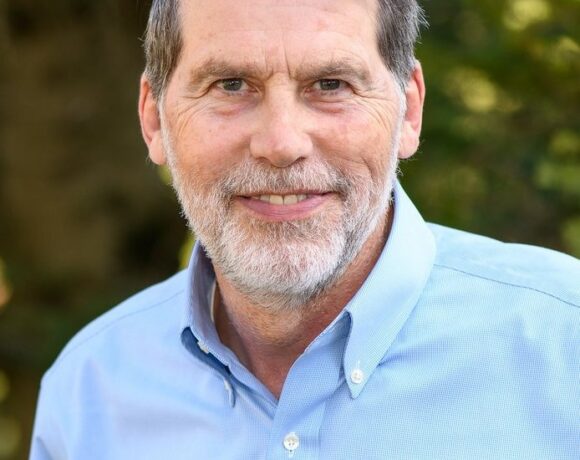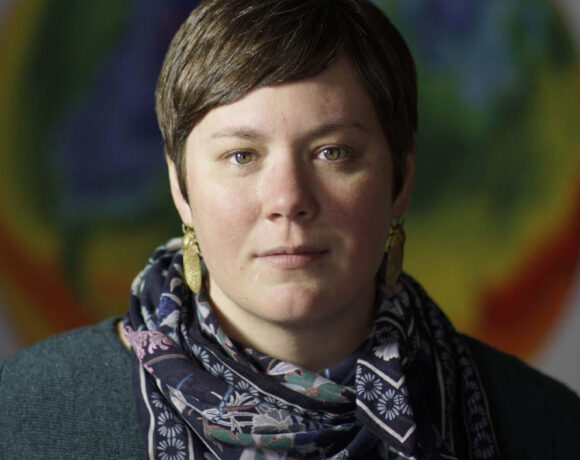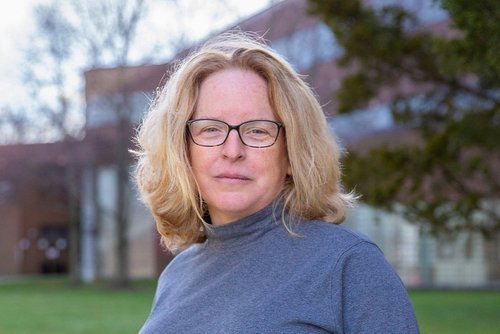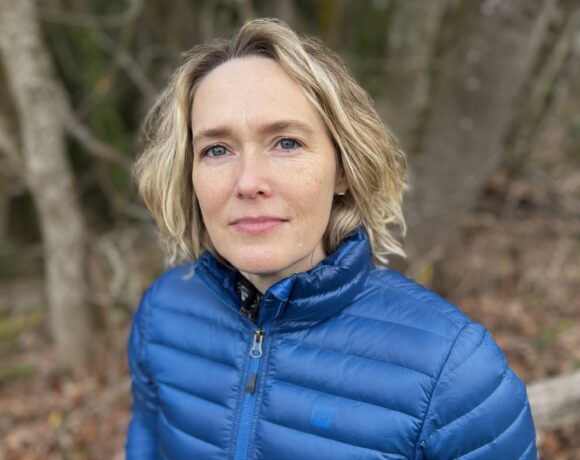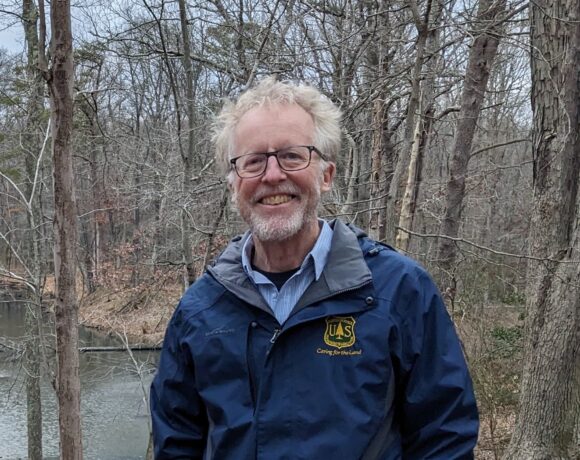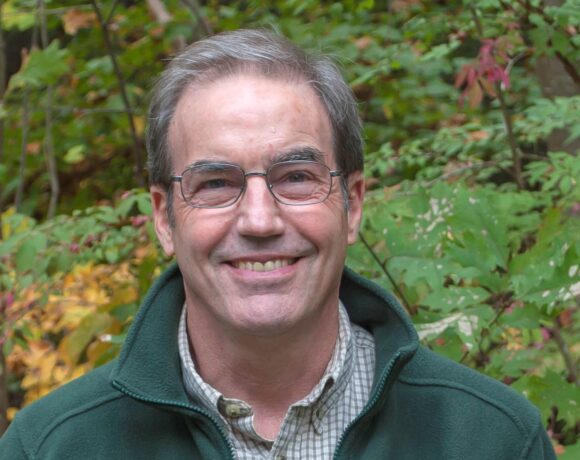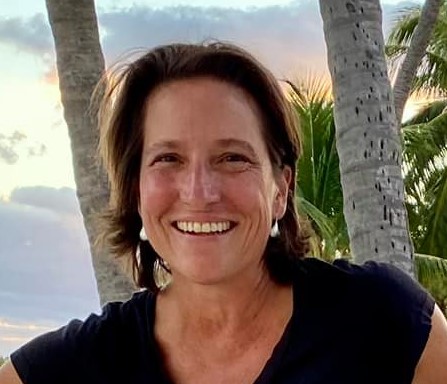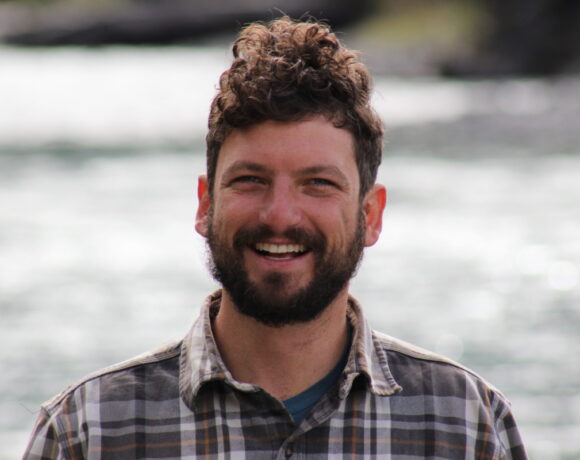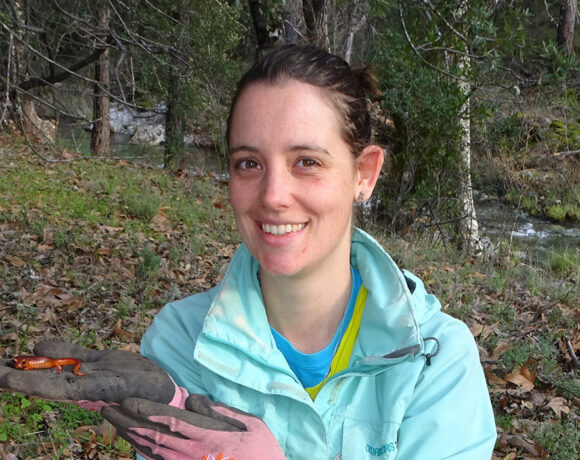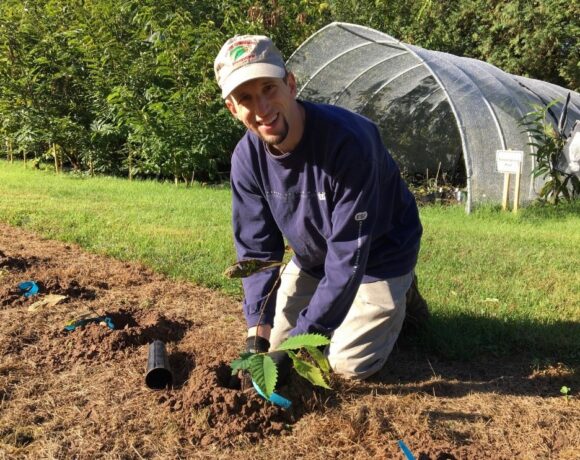This month, we sat down with Dr. Annette Evans, a postdoctoral researcher at UMass Amherst/Northeast Climate Adaptation Science Center, to talk about her work, which combines invasion ecology and climate change to inform land management by modeling abundance and distributions of invasive plants.
Watch the interview here:
View transcript:
Justin Dalaba (JD): Alright, Hi, Annette. Thanks so much for joining us and participating in one of our spotlight interviews. We’re really excited to talk to you, and you and I know each other through the northeast regional invasive species and climate change management network, which has been a really exciting effort to be a part of, and I think we both joined around the same time. So, for those who don’t know you and who you are, tell us about you, your work, and your current role with UMass Amherst and the Northeast Climate Adaptation Science Center.
Annette Evans (AE): Sure. Hi everybody. My name is Dr. Annette Evans. I am currently a post-doctoral research associate or post-doc at University of Massachusetts, working with Bethany Bradley. And, as Justin mentioned, part of my role is involved with the northeast RISCC, and I’m also part of the northeast CASC network. And so, for my current position I’m working a lot on invasive species, particularly invasive plant species, because that’s what our lab currently focuses mostly on. And my project is really interested in mapping invasive plants across the United States, and at the moment we’re focusing on sort of the northeast, or eastern region of the United States. And we’re particularly interested in how climate change is likely to change the invasion risk that these plants pose. And so one way that our research is a little bit different than what’s been done previously in this area is that we’re looking at not only where a plant could occur with climate change, but also those regions that it could reach high abundance.
JD: Totally. And so, I’m wondering if we could take a little deeper dive into some of the methods that you’re using to sort of get at those research questions, because obviously climate change is difficult to predict and there’s so much uncertainty around it. So, how are you going about that?
AE: Yeah. So, we’re using species distribution models to try to evaluate future invasion risk. So there’s a lot of different model algorithms out there. Our approach uses five of the possible algorithms that you could use. Uh, it’s kind of convoluted and complicated, so more involved than we can get into in this brief discussion. But essentially what my research takes is, we gather um information on where and invasive plants are currently established at high abundance. And here we’re considering abundance as like a percent cover. So, if a species can reach at least 5% cover, we assume that they are able to reach high abundance in the United States. And so, we find those regions through, you know, data that managers and members of the public and scientists have made available online through things like EDDMapS. And then we take those localities and we look at the climate variables, the different environmental variables that occur in those regions to see if we can correlate what environmental conditions help support those abundant populations, and then, using those species distribution models, we look at what other regions, based on our current climate and with climate change, are expected to show similar environmental conditions, so that we can identify locations that these various invasive species are likely to reach high abundance in the future.
JD: So, just to clarify a bit. What are some of those environmental variables? And could you also speak to some of the focal species that this might apply to?
AE: Yeah, so my work uses eight different environmental variables. One of the most common ones is minimum winter temperature, so we know that there are a lot of restrictions on where species can occur based on their ability to survive those really extreme temperatures, and we know that with climate change that that’s likely to be shifting northwards. So, obviously our winters are getting warmer, and that’s going to allow new species to maintain populations in the future where they maybe can’t at the moment. Um. And so, for my study I’m looking at one hundred and forty-four different invasive plants that are already established here in the Eastern United States, but also likely to be shifting their ranges mostly northward. But that was part of our query is, where are they going? And how far are they going, or expected to go? I’ll be honest that I can’t remember all of them off the top of my head. But I know, for example, Kudzu is one of those species that is included in that data set, and is expected to be shifting towards the northeast with climate change.
JD: Yeah, one hundred and forty-four species is a lot to remember. And I think one of the things that’s so interesting to me about your work is that it does take this larger ecosystem scale approach. And so, I’m wondering if you could speak a little bit more to, how does this apply to the broader field of invasive species, management, and prevention? Because I think your work is so valuable in thinking about the restoration and management strategies with invasive species, and not only right now, but moving into the future and trying to predict, how are we going to best manage these systems?
AE: Yeah. So, for people who are already involved in invasive species management, it’s pretty well recognized that the earlier you can intercept and start managing species invasions the better off you’ll be. So ideally, we want to prevent species from establishing in the first place, and then those that are already established, we want to try to keep those numbers as small as possible. When you sort of think, you know, those of you with backyards, it’s easy to pull up just a single plant than it is, if you had like a whole field of plants. So, the same kind of logic applies. And so, we know that from previous research that’s been done in the lab that up to one hundred invasive plants were identified as likely to be able to colonize areas in New England with climate change, and a hundred species is a lot of species for land manages to be managing on top of the ones that they already working with. And so, one of the main goals of this project was, okay, well let’s see if we can narrow down that list of one hundred species to just find ones that are not only able to establish, but also able to reach those high abundances. And part of that is because abundance is often correlated with impact. The more individuals you have, the higher the likelihood that they’re going to have those negative impacts. So, if we can focus in on those really high impact ones, that can help shorten that list and enable more proactive management with climate change, is the hope at least.
JD: Yeah, totally. And I’m wondering, you know, we’ve already alluded to this… It’s obviously really difficult to sort of research and predict this in natural systems. And so, a lot of it is through modeling. So, I’m hoping you might be able to speak to what are some of the findings so far in in your work. And maybe, is there something that’s really compelling or interesting? Um, that you think is helpful for managers to know?
AE: Yeah, So I mentioned that we modeled those one hundred and forty-four species. And it turns out that with climate change, about one hundred and thirty-four, of those one hundred and forty-four are likely to have area in the Eastern United States that is capable of supporting those high abundance populations. And so, at the moment we’re looking at what are the areas where we see the highest number of those abundant invasive plants? and at the moment, there are sort of three general regions, so like Florida and along the eastern seaboard of Georgia, and then also sort of lower New England area, and also around the Great Lakes region. Those are the current regions, and there are about thirty of those invasive taxa that are currently predicted to be supported in those hotspots as we call them, and with climate change we are predicting that those hotspots to move about two hundred and twelve kilometers north, mostly towards the northeast; and what I work is showing is that for these abundant populations uh these regions in the Northeast are likely able to support twenty-one new, or up to twenty-one new invasive plants that can reach high abundance. So that’s a lot of species. But it’s a lot less than that one hundred that we’re identifying using the occurrence-based models. And so, it’s looking like this work could be helpful for informing that proactive management for uh, the northeastern region. So, that’s pretty exciting.
JD: It is exciting. And then I think about the managers on the ground that are like wow, twenty-three or twenty plus new species, that’s a lot like that can be overwhelming. So then, the question is like, what do we do? How do we best prepare for this? So, like? Do you have a sense of recommendations for what that means on the ground? What is your best advice for someone in a management role?
AE: Yeah, that’s challenging, because obviously like time and money constraints. And these are up to twenty-one species on top of ones that are already there and likely to persist. Um, so I will say twenty-one is the upper limit. On average, there are only four species. And as part of this research we are providing state lists. So, for each State that’s east of sort of Texas region. There are individual state lists of species to show the area that is likely to be suitable, for high abundant population. So, the idea is, you know, people who are working in. I don’t know. Vermont, for example, can look up through the Vermont list and figure out okay, which species are likely to have the highest and largest area that’s capable of supporting abundant populations and use that as their prioritization in the prioritization strategy. We’re also hoping that we can leverage the northeast RISCC network to disseminate both these results, and also facilitate communication between these land managers, because obviously some of these species are already established somewhere else in the United States, and a lot of these regions, they already being managed so like down south of Florida way. And so, it’d be great to connect those managers so that they can share what’s worked and what hasn’t worked. Things like that.
JD: Yeah. And so, you mentioned the Northeast RISCC. That’s the Regional Invasive Species and Climate Change management network, which we opened up with saying, we’re both a part of that leadership team. So, tell me more about that in your role with that. And I’m also curious to hear, you know, like from your independent work, and through collaborations like RISCC, how has that maybe reshaped your perspective and how you’re thinking about the future of ecosystems and management with invasive species and climate change? Two really pressing, uh uncertain environmental issues.
AE: Yeah, that’s a really great question. So I started with RISCC about the same time as Justin, we’ve both started, I think Summer of 2021. Is that about right? Yeah, I’ve really enjoyed my time there. So, I did not have a strong sort of practical application in terms of research prior to joining this research group and joining RISCC. My background was more focused on, you know, here some interesting biological questions and let’s look at like ecological and evolutionary impacts of like climate change or invasive species on a particular species. Um, and so it’s been really interesting to hear about how primary research done by scientists is actually used out in the field. And obviously there is this discrepancy between, you know, what we, as scientists might think, is helpful compared to the information that managers who actually using, you know, boots on the ground folks actually want and use. And so, that’s been really eye opening, and it’s been exciting to be part of that and making resources that can actually be used to make a difference.
JD: Yeah, I couldn’t agree more. And I guess while we’re on that vein. How did you land where you are today? So, you know you started out studying University of Auckland and went on to do your PhD at University of Connecticut. And now you’re in Connecticut working in the northeast. What sort of drew you to the States? Or how did you kind of find an interest in invasive species to begin with?
AE: Yeah, it’s a great question. Yeah. So, you’ve probably heard my accent, people who are listening. So, as Justin mentioned, I’m originally from New Zealand. I was born and raised, did all my undergrad at University of Auckland, and I was really fortunate. New Zealand has a very strong and invasive species, focus and awareness, and obviously a lot of conservation action. And a strong focus on preventing species from arriving and establishing in the first place. So that was part of my upbringing. We’re very aware of things. I remember, as a kid, airplanes doing aerial spraying for painted apple moth, a caterpillar that we did not want at the time. And so that was part of my upbringing, and so I was always interested in invasive species, and was really fortunate that my master’s degree at the University of Auckland was in biosecurity and conservation. And so, we had this really strong practical application, went to the ports of Auckland to like look for invasive ants. Things like that. And so, I was always really heavily involved. Um took a slight detour, based on my own field interest. I’m also a herpetologist. So, I love reptiles and amphibians, for my masters and my Ph.D, actually focused on reptiles and amphibians respectively, but still within this realm of how humans, so anthropogenic stresses, so either invasive species movement, or climate change impacting these native animals and ecosystems. And so, after my PhD I had this opportunity to join the in a special ecology lab at UMass in this post-doctoral position, and it was just really exciting to be able to get back to that invasive species roots and sort of reaffirm those connections that I had back home.
JD: Very cool. Two things that you and I also share in common. I also studied herpetology prior to this, and that’s a big passion of mine, and I also did study abroad in New Zealand, and it’s interesting you mentioned that you know that’s such an important part of the culture and environmental policy there, like I remember flying back, they had to wash my hiking boots or tramping boots, as they call them there. To make sure there was just no trace of anything that could be spread to other countries. So, it’s definitely embedded in the day to day there. So cool. And so, you know you’re still kind of earlier in your career. I’m curious, if you might be able to speak to, what are your kind of high-end long-term goals? What do you think or hope the long-term impact of this work that you’re doing will be?
AE: Yeah. So, I’m really passionate about conserving native ecosystems, whether that’s the system as a whole, or all the components of that ecosystem. And so, most of my work, prior to this post-doc has been focusing on individual species. So, in New Zealand I worked on two native gecko species and my post-doc is focused on a native salamander native to the Northeast. And so, I’m hoping that through that research and the research and I’m currently involved in that we’ll be able to conserve that biodiversity into the future, because obviously climate change is not going to be changing. We’re going to continue to be modifying ecosystems, because that’s just the world that we live in. And so, finding this way to work in harmony with nature around us, to preserve those populations and see how they’re responding to us too. That something I’m really passionate about.
JD: Love it. I definitely appreciate that perspective. Well, I guess that really only leaves a couple other questions. The next is, what lies ahead for you and for your work with RISCC?
AE: I have some exciting new developments in my near future. Actually starting next week in November, I’m starting a new postdoc position as part of the broader RISCC networks. So, the regional invasive species and climate change network has expanded beyond the northeast, and there are now, five or six other regional RISCC networks that are establishing. And so, I have a new post-doc position working in conjunction with all of those RISCCs to try to synthesize survey results that they’ve conducted of the manager community that they hope to serve, to identify areas that those managers in each of those regions identify as like high risk or high interest for their work, and to try to synthesize those results across the network as a whole, and work with the national Invasive Species Council to help move forward a more connected network of researchers within the RISCC network.
JD: Yeah. Congratulations on that. It’s really exciting opportunity. I’m excited to see where that takes you. Is there anything that we didn’t cover that you would like to speak to or add to the conversation?
AE: I will encourage everybody who is not already on the Northeast RISCC listserv to join. We’ve got some exciting research both from my project and then others, as part of the spatial ecology lab that is coming out within the next year, fingers crossed, and one way to keep in touch with that is through that RISCC network. So, I’d encourage everybody to join.
JD: I will echo that, it’s a great resource, with lots of new content coming out regularly, and definitely subscribe if you aren’t already. Well Annette, thanks so much for taking the time to chat. This was an awesome conversation, and I think climate change is more and more in our minds as we’re thinking about invasive species into the future. And so, it’s great to hear your perspective and the work of others that really builds on that. So yeah, thanks again. And we’re happy to share this with our network.
AE: Thank you so much for having me. This was great.
For more info, visit:
Check out Annette’s latest research: An eco-evolutionary perspective on the humpty-dumpty effect and community restoration
More researcher spotlights:



